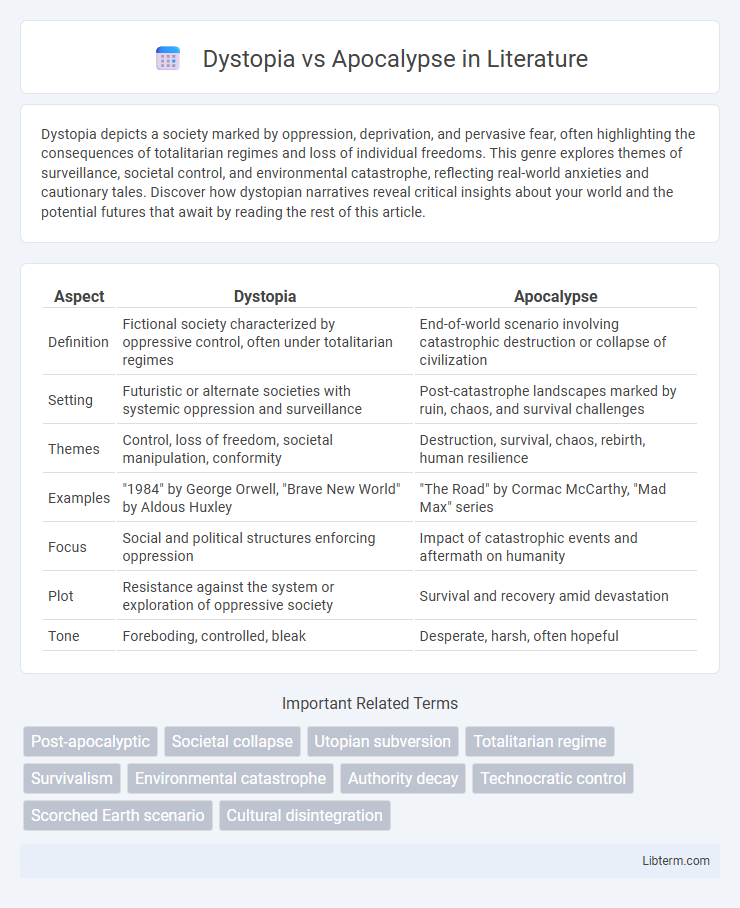Dystopia depicts a society marked by oppression, deprivation, and pervasive fear, often highlighting the consequences of totalitarian regimes and loss of individual freedoms. This genre explores themes of surveillance, societal control, and environmental catastrophe, reflecting real-world anxieties and cautionary tales. Discover how dystopian narratives reveal critical insights about your world and the potential futures that await by reading the rest of this article.
Table of Comparison
| Aspect | Dystopia | Apocalypse |
|---|---|---|
| Definition | Fictional society characterized by oppressive control, often under totalitarian regimes | End-of-world scenario involving catastrophic destruction or collapse of civilization |
| Setting | Futuristic or alternate societies with systemic oppression and surveillance | Post-catastrophe landscapes marked by ruin, chaos, and survival challenges |
| Themes | Control, loss of freedom, societal manipulation, conformity | Destruction, survival, chaos, rebirth, human resilience |
| Examples | "1984" by George Orwell, "Brave New World" by Aldous Huxley | "The Road" by Cormac McCarthy, "Mad Max" series |
| Focus | Social and political structures enforcing oppression | Impact of catastrophic events and aftermath on humanity |
| Plot | Resistance against the system or exploration of oppressive society | Survival and recovery amid devastation |
| Tone | Foreboding, controlled, bleak | Desperate, harsh, often hopeful |
Understanding Dystopia and Apocalypse
Dystopia represents a society characterized by oppressive social control, widespread misery, and the illusion of a perfect world, often used as a critique of current political or social trends. Apocalypse refers to the complete or near-complete destruction of civilization, frequently depicted as catastrophic events such as nuclear war, pandemics, or environmental collapse. Understanding dystopia involves analyzing systemic societal failures, while grasping apocalypse centers on recognizing the finality and transformative aftermath of catastrophic events.
Origins and Literary Roots
Dystopia originates from the Greek words "dys" meaning bad and "topos" meaning place, emerging prominently in 19th-century literature as a critique of societal flaws and totalitarian regimes, exemplified by works like George Orwell's "1984" and Aldous Huxley's "Brave New World." Apocalypse stems from the Greek "apokalypsis," meaning revelation or unveiling, rooted in religious and prophetic texts such as the Biblical Book of Revelation, symbolizing catastrophic end-times and transformative destruction. Both genres reflect humanity's fears through distinct lenses: dystopia explores oppressive futures shaped by human folly, while apocalypse presents cataclysmic events unveiling ultimate truths or new beginnings.
Key Elements of Dystopian Worlds
Dystopian worlds are characterized by oppressive government control, loss of individual freedoms, and pervasive surveillance that enforces conformity and suppresses dissent. Key elements include rigid social hierarchies, environmental degradation, and widespread misinformation designed to manipulate public perception. These settings often depict bleak futures where citizens face constant fear and deprivation under authoritarian regimes.
Hallmarks of Apocalyptic Settings
Apocalyptic settings are characterized by widespread destruction, collapse of civilization, and a struggle for survival amid scarce resources and hostile environments. Hallmarks include catastrophic events such as nuclear war, pandemics, or natural disasters that reshape the world, leading to societal breakdown and chaos. These scenarios often emphasize isolation, loss of technology, and a grim atmosphere where humanity faces extinction or severe decline.
Common Themes: Control versus Collapse
Dystopia narratives emphasize themes of control, often depicting societies governed by oppressive governments or surveillance states that restrict individual freedom and enforce conformity. Apocalypse stories center around societal collapse caused by catastrophic events like nuclear war, natural disasters, or pandemics, highlighting survival amid chaos and the breakdown of order. Both genres explore human resilience but contrast the imposition of external control with the consequences of systemic failure.
Societal Structures in Dystopia vs Apocalypse
Dystopian societies often feature oppressive governmental control, rigid class hierarchies, and pervasive surveillance designed to maintain order and suppress dissent. Apocalyptic settings, in contrast, depict the collapse of established societal structures, resulting in chaos, survivalist communities, and power struggles among fragmented groups. The fundamental difference lies in dystopias enforcing authoritarian stability, whereas apocalyptic scenarios reveal societal breakdown and decentralized, often anarchic, social organization.
Human Resilience and Survival
Dystopia and apocalypse narratives explore human resilience and survival through contrasting lenses; dystopias depict societies under oppressive control where individuals adapt by resisting or conforming to systemic constraints, highlighting psychological endurance and social strategies. Apocalyptic scenarios emphasize immediate threats like natural disasters or global collapse, showcasing physical endurance and resourcefulness in hostile environments. Both genres reveal core aspects of humanity's drive to persevere despite extreme adversity and disrupted civilizations.
Iconic Examples in Literature and Film
Dystopian works like George Orwell's *1984* and Suzanne Collins' *The Hunger Games* depict oppressive societies characterized by totalitarian control and social decay, often exploring themes of surveillance, loss of freedom, and resistance. Apocalyptic narratives, exemplified by Cormac McCarthy's *The Road* and films such as *Mad Max*, focus on the aftermath of cataclysmic events, emphasizing survival amid devastated environments and societal collapse. These iconic examples highlight distinct thematic concerns: dystopias critique present societal trends through imagined futures, while apocalyptic stories explore human resilience in the face of existential destruction.
The Role of Technology and Nature
Dystopian narratives often portray technology as a controlling force that exacerbates societal oppression, highlighting surveillance systems, artificial intelligence, and genetic engineering as tools that undermine human autonomy. Apocalyptic stories, on the other hand, emphasize nature's retribution or catastrophic collapse, with environmental disasters, pandemics, and resource depletion serving as triggers that disrupt civilization. The interplay between advanced technology and the natural world in these genres reflects ongoing anxieties about humanity's reliance on innovation and the vulnerability of ecosystems.
Why Dystopia and Apocalypse Captivate Audiences
Dystopia and apocalypse narratives captivate audiences by exploring extreme societal breakdowns and existential threats, reflecting deep fears about the future. These genres immerse viewers and readers in worlds where centralized control, environmental collapse, or catastrophic disasters challenge human resilience and morality. Their vivid portrayals offer both cautionary lessons and thrilling escapism, fueling fascination with survival and societal transformation.
Dystopia Infographic

 libterm.com
libterm.com